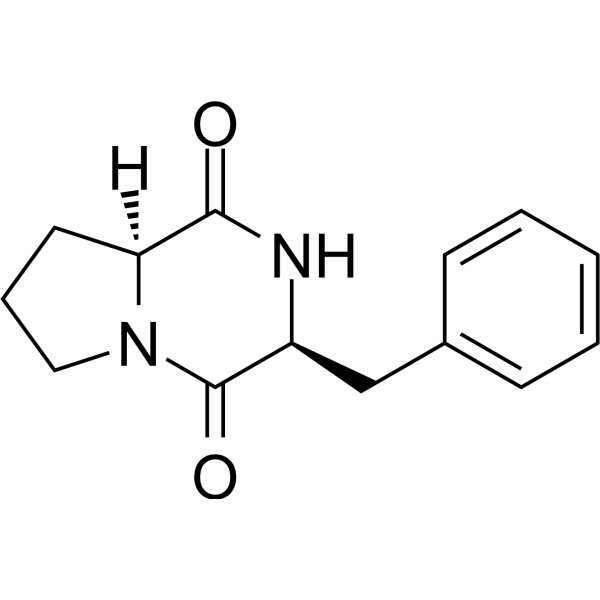
Cyclo(L-Phe-L-Pro)
CAS No. 3705-26-8
Cyclo(L-Phe-L-Pro)( —— )
Catalog No. M31407 CAS No. 3705-26-8
Cyclo(L-Phe-L-Pro) shows broad-spectrum antibacterial and antifungal activities. Cyclo(L-Phe-L-Pro) exhibits activity against methicillin-resistant S. aureus and Enterococcus raffinosus.
Purity : >98% (HPLC)
 COA
COA
 Datasheet
Datasheet
 HNMR
HNMR
 HPLC
HPLC
 MSDS
MSDS
 Handing Instructions
Handing Instructions
| Size | Price / USD | Stock | Quantity |
| 5MG | 53 | In Stock |


|
| 10MG | 78 | In Stock |


|
| 50MG | Get Quote | In Stock |


|
| 100MG | Get Quote | In Stock |


|
Biological Information
-
Product NameCyclo(L-Phe-L-Pro)
-
NoteResearch use only, not for human use.
-
Brief DescriptionCyclo(L-Phe-L-Pro) shows broad-spectrum antibacterial and antifungal activities. Cyclo(L-Phe-L-Pro) exhibits activity against methicillin-resistant S. aureus and Enterococcus raffinosus.
-
DescriptionCyclo(L-Phe-L-Pro) shows broad-spectrum antibacterial and antifungal activities. Cyclo(L-Phe-L-Pro) exhibits activity against methicillin-resistant S. aureus and Enterococcus raffinosus.
-
In Vitro——
-
In Vivo——
-
Synonyms——
-
PathwayOthers
-
TargetOther Targets
-
Recptor——
-
Research Area——
-
Indication——
Chemical Information
-
CAS Number3705-26-8
-
Formula Weight244.3
-
Molecular FormulaC14H16N2O2
-
Purity>98% (HPLC)
-
SolubilityIn Vitro:?DMSO : 250 mg/mL (1023.37 mM)
-
SMILES——
-
Chemical Name——
Shipping & Storage Information
-
Storage(-20℃)
-
ShippingWith Ice Pack
-
Stability≥ 2 years
Reference
molnova catalog



related products
-
Di-O-methylcrenatin
Di-O-methylcrenatin is a natural product of Photinia, Rosaceae. Di-O-methylcrenatin can be used as a reference standard.
-
(Z)-Thiothixene
(Z)-Thiothixene is an serotonergic receptor antagonist.
-
5-(5-methyl-1H-1,2,4...
5-(5-methyl-1H-1,2,4-triazol-3-yl)-3-[4-(trifluoromethoxy)phenyl]-1,2,4-oxadiazole can be used in the synthesis of heterocyclic compounds to inhibit HIF pathway activity.



 Cart
Cart
 sales@molnova.com
sales@molnova.com


